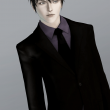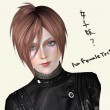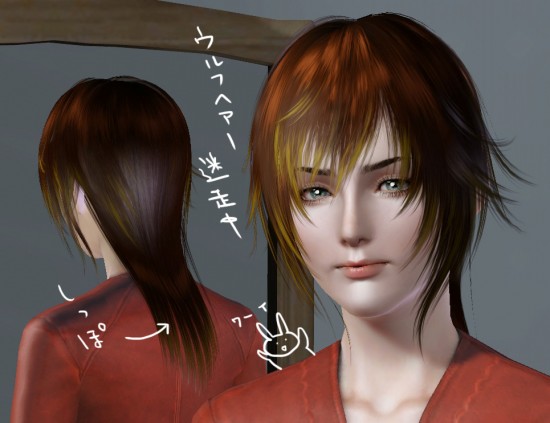ウフルヘアー




色々作りたいものがとっちらかっているんですが、とりあえずたんぶら記念。モデルを設定しない場合は、基本的に何も考えずに自由にモデリングするのですが、そんなことをしていたら前回の500記念と似ていたでござる。お前どんだけ外に跳ねさせるのが好きなんだよ。最初はロングを作ろうとしていたのですが、これに普通のロングだと重いのでウルフになってきました。でも正直ウェイトの設定が面倒くさいから、後ろはショートにしちまおうかとか色々アレしてます。ちょっとまたライトニングさんっぽい。手前事ですがウルフは私もよくやります。ウルフってアレンジによって、ショートの印象でロングというイイトコ取りなんですよね。でも、後ろもトップも結構削ぐので、気をつけないとすぐに髪が傷むという。あ、動物占いも狼なんですよ。狼って「一匹狼」って言葉があるからついうっかり孤独を好む動物の代名詞みたいですが、本来狼は群れをなす動物です。あ、某委員長が飛んできそうですね。本来群れる動物であるに関わらず、群れていない珍しいヤツ=「一匹狼」というわけです。しかし、グーグルトップの動物占いの書き方だと、そもそも狼そのものが群れないみたいな感じに読めますね。動物占いも何かいっぱいあってどれが本家本元なのかよくわからないけど、だいたい合ってます。
*
因みに子供用眼帯モデルはこれと一緒の作成ファイルに入ってます。ちょっと髪の毛飽きたぷーってなって、突発的に眼帯作り始めたよこの人!みたいな。あまり手間がかかってないんですが、ちょっとの手間で色々楽しいからアクセサリって面白い。大人用に比べるとやっぱり子供のアイテムって少ないですよね、やっぱり子シムがぶさいk なんでだろうね?(^^) なんていうか、子供はモデルの段階で結構クセがあるんですよね。子供用スキンで無理矢理アレしてるけど、基本唇とかタラコ気味だし。なんだろうな、顎周りがふとましいというか。姿勢も猫背気味だし、華奢にならないんですよね、健康優良児!って感じ。子供があまりに可愛くないと、髪型作ってて子供用まで作る気力がw やっぱり、かぶせたときに「うわー可愛い!」って思いたい。思いたいのだよ。でも、兵長のときに教えてもらった、顔の長さ変えるスライダーでだいぶ子供も可愛くなったと思うの。ありがてぇ。
PREV ≪ お子様用眼帯 | Arráncame la vida ≫ NEXT
Related Posts
-

-
HK
某雲の人(っていうと故人っぽい) 10年後版。この毛と一緒に
-

-
へいちょ!...
わりと兵長漬けの週末でした(´-` ) どうも↑のこの顔が某
-

-
Intuos5
自分へのご褒美()にIntuos5を買っちゃった(´∀`)♪
-

-
セバス髪女性版...
先週末はヤヴァイ程PCと一緒に居る時間が長かったわ・・・(´
-

-
進撃の巨人14巻...
まだまだ先だと思っていたら、今日発売だったんですね。Twit
-

-
私が死んでも代わ...
なんともブラック企業のかなりキてる社員のような発言ですね。ネ



Comment or trackback
Someday, I hope you will do some Free! Iwatobi Swim club hairs or sims. <3
Btw, thanks for the hard work.
> Dear Maru
>>Someday, I hope you will do some Free! Iwatobi Swim club hairs or sims. <3
I'm sorry, but I don't understand what you mean.(?_?) What is Iwatobi Swim Club???
Umm…I think Maru means this one: http://ja.wikipedia.org/wiki/Free!_(%E3%82%A2%E3%83%8B%E3%83%A1)
> Dear Mich-Elsa,
Oh, I see! Thank you for your support.
–
> Dear Maru,
Sorry, I didn’t know that anime.